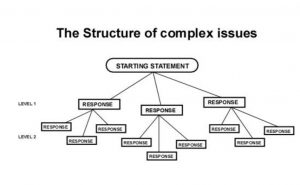Understanding the Structure of Complex Issues
The point is that all big issues have this fundamental treelike structure. Technically it is called a logical form. Hopefully just knowing the big tree is there and growing can reduce frustration when dealing with a complex issue.
We live in a world of complex issues, which can be very frustrating. I have been doing research on the generic structure of issues for a long time. There is an underlying pattern that  might be helpful to know about. I call it the issue tree. What follows is necessarily simplified to fit into a short article, but it is still a big step forward.
might be helpful to know about. I call it the issue tree. What follows is necessarily simplified to fit into a short article, but it is still a big step forward.
By a complex issue I mean one that generates a lot of discussion. Policy issues are a good example, as these can involve hundreds or even thousands of articles and comments. The issue tree explains how this happens.
The graphic below shows a simple start to an issue tree. First there is a starter statement, followed by three responses, each of which also gets three responses. In policy cases the starter might be a radical proposal for dealing with a perceived problem. Or it might be the controversial claim that a major problem exists.
There are two levels of responses. First level responses can be objections to the starter statement, questions, additional information, etc. At the second and successive levels there are responses to previous level responses. In many cases there are two or more sides to the issue, generating lots of discussion over time.
At this point you may say, so what? There are just 13 statements. How is this complex? Here the arithmetic gets interesting.
First of all, in a major issue the tree can get very big. This tree has a branching rate of three, that is, every node that has branches going down has three such branches. Thus each level has three times as many responses as the one above it. The number of nodes at level n is three to the nth power.
At this branching rate, which is common in policy debates, the number of nodes gets very large, very quickly as the discussion continues. At just the tenth level there will be almost 60,000 nodes! The whole tree will have around 100,000 nodes.
I call this the big tree problem. In a major issue it is not unusual to have 100,000 sentences written, or even a million. For example, consider this question: What is cancer and how should we deal with it? There are over 100,000 research papers alone each year on this, plus a world of other writing. The issue tree of cancer research is enormous.
As a result of the big tree problem people are simply swamped by the complexity of the thinking.
Also Read : Global Response to COVID19: Why TRIPS Provisions Must be Waived?
They sense correctly that there is a lot more to the issue than they know and this is frustrating. Or perhaps they feel that there is not more (which is incorrect) and cannot understand why people do not agree with them.
What one can do under these big tree circumstances is to (1) master the top of the tree, (2) dig into a few sub issues and (3) understand the magnitude of the issue.
Note that grasping the top of the tree can be difficult under certain circumstances, especially where the responses are not written down for reference. In a meeting to discuss a new issue the branching rate is often well below two, because it is hard to get back to early responses.
Another source of frustration is what I call the jumping problem. This happens with writing and talking about a complex issue. It occurs because writing and talking are both physically linear, in the sense that we only produce one sentence at a time, one after another. Because we do that it is not possible for each response to immediately follow the statement it is responding to.
 As a result, we are frequently forced to jump from one place in the issue tree to another. For example, if you follow a series of responses down several levels, then jump back up toward the top, to consider another high-level response.
As a result, we are frequently forced to jump from one place in the issue tree to another. For example, if you follow a series of responses down several levels, then jump back up toward the top, to consider another high-level response.
Jumping can easily cause misunderstanding, which is very frustrating. When a jump occurs, the statement being made is not directly related to the statement that preceded it. It may be a response to a much earlier statement. When reading or hearing such a jump statement it is easy to fail to make the proper response connection.
Different responses may have very different strengths or degrees of importance. Who says what may also be important? We can also consider how big various sub issues are, or look for places where important responses are lacking, so there is no sub issue at all. WE can watch a sub tree come to life and grow rapidly because it is the present center of attention.
In fact there is a whole new science here, which I call issue analysis.For people who want to know more I have a free textbook online: “Issue Analysis, an introduction to the use of issue trees and the nature of complex reasoning.”It is rather crude because I did it just for my own classroom use, on an ancient mechanical device called a typewriter, in 1975. I discovered the issue tree in 1973 and here is a bit on the early history:
The point is that all big issues have this fundamental treelike structure. Technically it is called a logical form. Hopefully just knowing the big tree is there and growing can reduce frustration when dealing with a complex issue.
(Note: This article was first published on cfact.org)
